Consequently, the right choice of rheological additives for a specific task is becoming increasingly important,3,6-7 especially as optimum flow properties play a major role in the success of waterborne coating systems. The large number of different, commercially available products does not make this choice very easy. The aim of this article is to first give a brief summary of the different rheological additives on the market, and to then make recommendations on the choice of suitable systems with the aid of a few selected examples.

Coarse Classification of Rheological Additives
Rheological additives can be roughly divided according to their chemical nature into inorganic and organic thickeners, with a subsequent distinction being made between thickeners for solventborne systems and thickeners for waterborne systems (see Figure 1).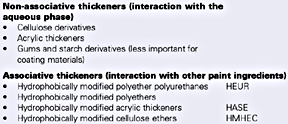
If we take this distinguishing characteristic as a basis, thickeners can be broadly divided into two different groups.9
One group is made up of the high-molecular-weight, non-associative thickeners such as cellulose ethers and polyacrylic esters. Complementary to these are the associative thickeners such as HEUR polyurethane thickeners (Hydrophobically modified Ethylene oxide Urethane Rheology modifiers), HASE (Hydrophobically modified Alkali-Swellable Emulsions) and HMHEC (Hydrophobically Modified Hydroxy Ethyl Cellulose) (see Figure 2).

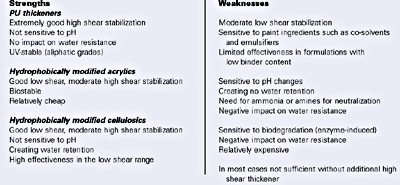

The given shear ranges are of differing importance for the surface coating. While in the lower shear range, properties such as pigment stabilization, syneresis, anti-settling tendency and leveling are negatively affected, the medium shear range is of importance for properties such as coating consistency, miscibility and pumpability. High viscosities, even under high shear, are responsible for film buildup, covering power, spattering tendency, brush drag and rolling resistance.1
Important Factors for Choosing a Suitable Rheological Additive
When selecting one or more suitable rheological additives for a formulation, various factors must be considered. To begin with, it is the kind of coating system and method of application that play the most important role. Decorative paints for doors and window frames and emulsion paints for brushing or rolling make different demands on the rheological characteristics of a coating system than industrial coatings for application by spraying, roll coating, curtain coating or dipping. Since rheological additives can also influence film properties such as gloss, water resistance, weather stability, wash resistance and corrosion resistance, the intended application -- and consequently the specifications for the surface coating -- are of particular importance when selecting a rheological additive.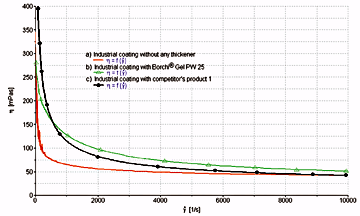
Type of Coating System
Which rheological additive is suitable for a given system depends on the coating formulation and, in particular, on the type of binder being used. The widest choice is with formulations based on polymer dispersions that can be combined very well with both non-associative and associative (apart from a few exceptions) thickeners. By nature, formulations with a high binder content react far better to the addition of associative thickeners than formulations with a low binder content (see Figure 6). The same can be said of fine dispersions, which respond far more intensively to the use of associative thickeners than coarse dispersions.If, however, a thickener is needed for an emulsion (e.g., an epoxy or alkyd resin emulsion), the choice is somewhat more limited. Here, associative additives are generally ruled out because they thicken the emulsion merely through intrinsic association, which is not particularly effective. In such cases, alternatives would be high-polymer additives such as cellulose ethers or acrylate thickeners.

Application
The intended method of application is another factor influencing the choice of a suitable rheological additive. If the paint is to be sprayed, good leveling (results in good gloss and covering power) and a low sagging tendency (prevents the paint from running down on vertical surfaces, also called curtaining) are needed. Ideally, use would be made here of a thickener with pronounced pseudoplastic properties. High shear forces, introduced as the coating passes through the spray nozzle, lower the viscosity enough to ensure good leveling of the spray droplets. Subsequently, the higher initial viscosity returns, and sagging is avoided. The high level of effectiveness of a pseudoplastic thickener under low shear forces can, in appropriate formulations, also prevent sedimentation of the fillers and pigments.

With curtain coating, the result is dependent on the stability of the curtain coating film. Any tearing of the film leads to coating defects. In such cases, Newtonian (high shear) thickeners have proved particularly useful because they keep the coating viscosity virtually constant, even in zones of different shear.
Coatings, including emulsion paints, for brushing or rolling make similar demands on the rheological profile and necessitate a thickener that is highly effective even at high shear rates.1 Good coating results can only be achieved by brushing or rolling if the viscosity of the relevant coatings remains high even under high shear rate (brush drag). If the brush drag is inadequate, a considerable proportion of the coating applied to the surface is pushed along in front of the brush or roller without sticking to the substrate. This results in poor coverage, uneven application and poor leveling (see Figure 8).


Use of the Coating System
Apart from the kind of rheological profile created by a rheological additive, there are other properties that play a key role in whether a certain additive is suitable for a specific application. Cellulose ethers, for example, have properties that sometimes make them irreplaceable, especially for emulsion paints. Through their intensive association with water, they delay the drying of an emulsion paint (water retention) and prevent the water from "disappearing" into highly absorbent substrates (see Figure 10). Thus they help to create a uniform coating even on surfaces with varying absorption. The higher the quantity of cellulose ether (normally approx. 0.5%) in the formulation, the better the effect.
For extremely cheap emulsion paints, the cellulose ether can also be replaced with an acrylate thickener.10 It must, however, be taken into account that coatings formulated in this way are sensitive to pH fluctuations, have inadequate water retention and also have certain deficits in their water resistance, which means that they can only be used indoors.
If, in addition, the brush drag and anti-spattering tendency of the paint are to be optimized, this is done with the aid of suitable high-shear thickeners. New polyurethane thickeners such as Borchi Gel VP 0013 and the virtually twice as effective Borchi Gel VP 0024 have been developed specifically for this purpose (see Figure 11).
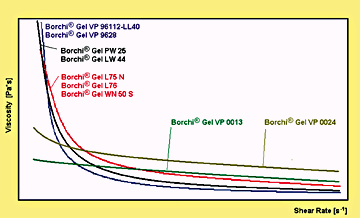
In paints exposed to weather, it is therefore more common to use only polyurethane thickeners. Although they are often not as effective as acrylate thickeners or cellulose ethers in the low shear range, they do have very good weather stability and water resistance. Thanks to the variety of commercially available products that are optimized to the different shear ranges, it is possible to create almost any desired rheological profile (see Figure 12).
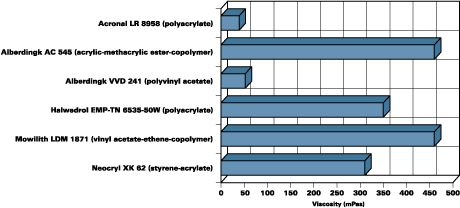
Polyvinyl acetate dispersions, for example, are very difficult to thicken, whereas styrene acrylates and straight acrylates generally thicken relatively easily. Differing polarity or morphology of an acrylate dispersion also exerts a considerable influence on the effectiveness of an associative thickener, as is shown by the comparison between various commercially available acrylate dispersions (see Figure 13).
However, other components in the coating such as solvents and emulsifiers also have a considerable influence on the rheology. Nonpolar solvents, for example, intensify the thickening effect of associative thickeners, whereas polar solvents (e.g., glycol ethers) appreciably reduce in particular the low shear thickening.3,11
Conclusion
In an article such as this, it is only possible to give a general picture of the variety of decision criteria for or against a particular kind of rheological additive. A true optimization of the rheological properties to the requirements of a coating system can only be achieved through practical work with the relevant systems. However, keep in mind that expert advice can save a lot of time and money.This article was originally presented at the 6th N?rnberg Congress, April 2001, in N?rnberg, Germany.
For more information on rheological additives, contact Peter Manshausen, Borchers GmbH, Alfred-Nobel-Stra?e 50, Bldg. 6610, D-40765 Monheim, Germany; phone +49 (0) 2173 38 2678; fax +49 (0) 2173 38 2696; e-mail peter.manshausen. pm@borchers.de; or Circle Number 139.
References
1 M?ller, J.; Thies, U. (Borchers GmbH, Monheim); Kober, H.; Mazanek. J. (BAYER AG, Leverkusen). "Verbesserung der anwendungstechnischen Eigenschaften von Dispersionsfarben durch Kombinationen aus Polyurethan-Verdickungsmitteln und Celluloseethern," 1997.2 J. Prideaux, Surf. Coat. Int. 76, (1993) (4), 180-183.
3 Schaller E.J.; Sperry, P.R. Handbook of Coatings Additives, Marcel Dekker Inc., New York, Basel, Hong Kong, Vol. 2 (1992), Kap. 4, 105-163.
4 Kaczmarski, J. Ph.; Fernando, R.H.; Glass, J.E. J. Coat. Technol. 65 (1993) 818, 39-46.
5 Mavex, T.L. J. Coat. Technol. 64 (1992) 812, 45-58.
6 Bielemann, J.H.; Riesthuis, F.J.J.; van der Velden, P.M. Polym. Paint Col. J. 176, June 11 (1986) No. 4169.
7 Na?H.N.; Bank, R.H. Rheology 91, October 1991, 170-178.
8 Einf?hrung in die Rheologie und Rheometrie, Gebhard Schramm, Gebr?der Haake GmbH, Karlsruhe (1995).
9 Shay, G.D. "A New Class of Alkali-Swellable Associative Thickeners," Surface Coatings International, JOCCA, Vol. 76, No. 11, 446-453.
10 Susterac, X. "Acrysol DR Verdicker", Schriftenreihe VILF-Vortr?, Band 2, 2000, 99-114.
11 Thibeault, J.C.; Sperry, P.R.; Schaller, E.J. Adv. Chem. Ser. 213 (Water-soluble Polym.), 375-389.

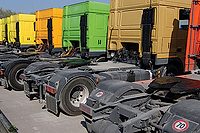

Report Abusive Comment